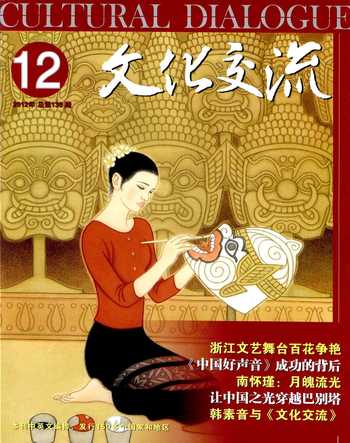月魄流光
2012-04-29赖晨
赖晨



今年中秋前夕——2012年9月29日的傍晚,南怀瑾先生走了。入夜,天心寥廓,月魄也流光。
一
南先生是成名于台湾的学者,与北京季羡林先生、香港饶宗颐先生并称当世,被人赞为国学大师。就学问言论,季先生艰涩而深厚,饶先生富丽而广博,南先生平实而奇出。南先生善讲学而多撰述,种数不下三五十,范围大都集中于经藏道法,兼达孔孟老庄,涉及卜易谋略、医药养生、堪舆营造、诗词书画。这与他常情莫测的经历相关。
南先生1917年出生于浙江乐清农村,是他父亲中年所得的唯一儿子,村老称“晚来佛子”,这给他的思想性格留下印记。小学肄业,他闲云闲水地散读书籍,积累了一些国学知识。之后,他求学于省城杭州的浙江国术馆习武教头,但一生基本未用。他喜欢在书店看理化类“大学丛书”,喜欢在孤山文渊阁翻《四库全书》。他去之江大学旁听过几节课,认为那里的教师学问不过尔尔,就不再去;也几次上英文补习班,感觉太难,竟弃之永久。传闻他曾借报业大亨史量才姨太太沈秋水的私家佛祠读道家古籍,并到西湖的荒野庵堂求仙访道,还拜学过城隍山的剑仙。
1937年抗战爆发,南先生在西南一带萍踪浪迹,办过实业,干过报界、军界,却仍不忘登临青城诸山寻觅道迹。自拜识巴蜀宗门大德袁焕仙后,他幡然似有所悟,潜心佛学,辗转川、康、藏的佛教传地,其间曾上峨眉修习,自言三年阅尽《大藏经》。1949年出走台湾前,他又返杭州,或说隐在天竺山中读《古今图书集成》。在台湾,他小商小贩式地生活,窘迫落拓,等日子有点转机,又在闹市闭门谢客研经三年。1963年起,他相继受聘文化、辅仁、政治等大学而在家授课,未几,却频繁出入机关、团体、商社、会所各类讲台,讲稿在自办的老古文化事业公司出书不已,又旅美居港开设学堂,很快声名上升如月行中天。
二
南先生多佛说之作。1955年,他煮字疗饥的第一种书、介绍禅宗的《禅海蠡测》印行,定价5元新台币,但销售惨淡到连一本都卖不出。1960年,他作稻粱谋的《楞严大义今释》出版,依然乏人问津,末了有个肉商出钱买下一些书,谁知是回去拆开用来包肉。后来,此书偶被胡适先生读到、表示一定赞许,傅斯年先生、罗家伦先生也有点头,才逐渐畅销岛内外,人们评论说:“自从一读楞严后,不看人间糟粕书。”受到鼓舞,1965年,他的《楞伽大义今释》又问世。接着不断,他释义了《圆觉》《金刚》《心经》《药师》《维摩诘》等经籍,被人视作启蒙彼岸的教材。
南先生也重儒道之学。1976年的《论语别裁》是一种讲演录,他把二十篇原文的每一段撮编为一个故事来串讲。据说,此书洛阳纸贵,重印18版之多。另外,他先后有《孟子旁通》《老子他说》《原本大学微言》《庄子諵哗》《列子臆说》等门径之书。台湾曾有新闻:澎湖马公市有一对男女青年按古代礼仪成亲,双方互赠《论语别裁》《孟子旁通》为信物,哄传一时,可见南先生影响力之一斑。1987年的《易经杂说》和2009年的《我说参同契》也是讲记,前者介绍一般知识、解释六十四卦,后者讲解周易、道家、丹道的有关概念和基本原理。
南先生也叙述其他中国文化的方方面面,比如1985年的《历史的经验》,讲谋略,一册针对《长短经》《战国策》《世要论》,二册针对《素书》《太公兵法》《阴符经》,是逐字逐句的解释。1986年的《中国文化泛言》为序跋杂著,讲瑜伽气功、保健养生、诗词歌赋、古文今译以及自己的行旅交往。《南怀瑾先生答问集》是2000年之后作者与学生的问答,包括“普通人修行学佛,需要什么条件”“人如何做到随遇而安”等。
上世纪80年代末90年代初,南先生的书风行大陆,有七八家出版社争相购买版权。《南怀瑾选集》十卷,收旧著24种。“太湖大学堂系列”图书,亦新亦旧。
南先生的书的特点是“比较”,不仅比较儒释道、比较诸子百家三教九流,还比较东西方文化,所以亦流行于不少国家和地区,总有十数种文字翻译。
南先生属于大器晚成者,可是著作仿佛月华泻地。
三
南先生有相当声望与影响,这大都由书而来,书大都从讲演而来,讲演大都为“功利”而来。他起初只因自身性格和精神追求写作,进一步因反对全盘西化、不忍中华传统文化日趋式微撰说,最终为社会为民众讲述。他曾赋诗“熟读经书徒论议,实行道义太伶仃”,发愿“欲为天心唤梦醒”。他坚持对纯学术的反动,说:我们读古书不是为了钻进古老的天地躲起来享受,而是为了建立新的文明,并且要了解如何发展未来。
自上世纪60年代中期在台湾成名以后,南先生时时处处讲演,前往聆听的政要巨头、名流学子,甚至贩夫走卒、闲散人员,极为踊跃。于是,他成立东西精华协会与十方丛林书院,自为家长,而会员、学员无分老幼尊卑,无分在俗出家,皆为同窗道友。
南先生也名出海外,引人瞩目,美、英、法、德、日、韩及加拿大、比利时、菲律宾、新加坡、马来西亚等国学者专家,纷纷登门拜访、学习。
加拿大学子文颢儒师出南先生门下,学成归国后出任文化部专员,公余之暇翻译《论语别裁》以广教化。委内瑞拉学者达易理跟南先生研习《易经》,返国执教于委内瑞拉国立大学,专任中国周易课程。美国佛门人士卡普勒,法号大心净圆,为寻禅宗之根,特意率弟子参访南先生,并介绍自己在欧美的弟子来求教。以一部《中国科学技术史》而闻名于世的英国学者李约瑟博士对道家学术极为推崇,在写这部巨著时,曾专程赴台湾访求有关资料。陈立夫先生陪同李约瑟与南先生相见,晤谈甚欢,兴致盎然。
1985年至1988年旅美期间,南先生又成立东西学院,致力于东西方文化沟通,弘扬中华学术。每天有各国各界的访客,他们不但来向南先生请教中国文化和佛学方面的知识,话题亦时常涉及经济、哲学、宗教及国际关系等。
1988年起的居港期间,蜚声海峡两岸的南先生继曹聚仁先生之后被选定为居中牵线人,在他的寓所重开秘密沟通管道。曹先生是著名爱国人士,而南先生虽然抱着“买票不入场”的态度参与其中,但同样为着民族统一大业和两岸人民的福祉。第一次会谈结束后,他分别给有关方面写信,表达自己及时抽身、乐观其成的心愿。信中说:“我本腐儒……一言兴邦,岂能望其必然”,“只望国家安定,天下太平,就无遗憾了”。
“我们中国古代的一些大儒,他们本身也许没有任何宗教的信仰;但是他们的立身行事,却于无形中表现了宗教家那种崇高的人格与献身的精神。”(刘真:南怀瑾《禅宗与道家》代序《举办宗教哲学专题讲演的旨趣》)南先生也许是。他的精神有时似热烈阳光,更多似清凉月光。
四
南先生有诗:“海外中秋月在门。”“何时回首照中原?”
南先生的声望与影响,不都集中于他的著作“惠及当世、泽被后人”,而是产生自故乡情大陆情,产生自事业感社会责任感。
仅以南先生在故乡温州地区为例,他多次资助过乐清的教育事业,捐款给泰顺、文成的台风受灾乡镇,援建了温州医药科技工程方面的研究院所和生命科学与保健的场所。最有代表性的是,他提议并出面主要筹资建设金温铁路。铁路完成之际,他提出“还路于民”,将股权转让给浙江省和铁道部。他说:“金温铁路是为子孙后代造福的公益事业。”
南先生曾出席孔子纪念会发表演讲。他借《易经系传》“举而措之天下之民,谓之事业”之语指出,“一个人一生里做一件事情,对世界人类永远有功劳,永远有利益给大家,这个才叫事业。像大禹治水,这叫事业,因此他为万世所崇仰,其功永不可没。上面最高到皇帝,下面最倒霉到讨饭的,都不是事业,那是职业。在座的工商界老板生意做得很好,赚钱很多,要讲事业那还差得很远”。这一番论述,赢得掌声。
2004年,南先生移居上海。此前的2000年,他在苏州太湖之滨主持创办太湖大学堂,2006年建成,有国内外一系列著名高校为合作机构,旨在传播中国传统文化,同时与现代自然科学、人文科学相结合。这当是他一生的最终理想和夙愿。
前人说,湖之形胜可以气蒸波撼;又说,太湖有大包孕的气度。南先生就从湖畔走了,他的治学理念和方法、学术思想和体系、成就贡献和意义,尚乏人整理研究,只留一轮空月。
(本文照片由作者和沈海滨提供)
Master of Buddhism and Classics
By Lai Chen
Master Nan Huaijin passed away on the evening of September 20, 2012, a day before the Moon Festival. Some remember him as a master of Buddhism and classics. Some remember him as a spiritual teacher. Some even go so far as to say that he is one of the big three masters of Chinese classics, ranking side by side with Master Ji Xianlin (1911-2009) and Master Rao Zongyi (b. 1917). Though he might not have been as profound as Master Ji and Master Rao, Nan is considered a legendary walking encyclopedia on ancient masters and ancient classics. He published dozens of books to tell people about the subjects covered by his extensive knowledge.
Born in 1917 in Yueqing in southern Zhejiang Province, he was the only son of a mid-age father in a village. Years later, he was to remember that some village elders called him a boy that Buddha sent to a blessed man growing old. The boy dropped out of primary school, but he read books of ancient classics haphazardly. After that, he came to Hangzhou and studied under the guidance of a Kongfu coach at Zhejiang Martial Arts Institute, but none he learned from the kongfu master turned out to be useful in his lifetime. He was more interested in knowledge and tapped into the sources the city offered: he read sciences in bookstores. He attended some lectures at Zhijiang University and dropped out after he found the teachers there had nothing special to offer. He spent a few nights at a crash course for learning English. He dropped out again, believing that the foreign language was too much a challenge. It is said that he studied Taoist books at a private library at a lakeside residence of a newspaper tycoon, that he visited some small religious temples around the West Lake and in the mountains beyond the lake, seeking a way to get enlightenment. Some say that he studied sword at City God Hill.
When the Chinese War of Resistance against Japanese Invasion broke out in full force in 1937, the 20-year-old went to the Southwestern China. In those years, he tried his hands at various things: business, journalism and military, but he still managed to find time to visit Buddhist temples in Sichuan and Tibet. Years later, he said he spent three years during the war years reading the Bonist Tripitaka, known as the encyclopedia of ancient Tibet. Before he went to Taiwan in 1949, he stayed in Hangzhou. It is said that he led a reclusive life in Tianzhu Mountain reading ancient and modern books. In Taiwan, he spent another ten plus years living a nameless life.
Nan Huaijin published his first book on Zen Buddhism in 1955. Not a single copy was sold. In 1962, he published a book on The Surangama Sutra, a Buddhist classic. Few were sold. Many ended up in the hands of a butcher who used the pages to wrap up meat for his customers. However, Nans second book was noticed and praised by Hu Shi, the biggest scholar of Taiwan of that time. Some more scholars gave his book a nod of recognition. In 1963, he found himself engaged in giving lectures at a few universities in the island and then he found many speaking engagements coming his way.
In 1965, he launched another ambitious book on Buddhism scripture. It became popular. Then he published a series of books on Buddhism and people bought and read his books.
In 1976, Nan Huaijin displayed another side of his understanding of Chinese culture. He published a collection of 20 lectures on “The Analects of Confucius”. It became an instant bestseller and was reprinted 18 times. He followed up this success by publishing books on other ancient masters and ancient topics such as military strategy, Book of Change, Yuga, health, poetry. In the late 1980s and the early 1990s, publishers on the mainland vied each other in publishing his books. The ten-volume Selected Works of Nan Huaijin published on the mainland contain 24 books he had published in the past.
It is said that Nans books focus on comparison. They compare Confucianism, Buddhism and Taoism; they compare the various schools of thought and their exponents during the period from pre-Qin era to the early years of the Han Dynasty; and they compare the east and the west.
Nan Huaijin lived in the United States from 1985 to 1988 where he set up an academy to promote exchanges between the West and the East. Then he moved to Hong Kong. During his stay in Hong Kong, his residence became a venue for representatives of the governments across the Taiwan Strait to meet secretly. In 2000, Nan Huaijin started the Taihu Great Learning Center in Suzhou, a city sitting on the great Taihu Lake. Completed in 2006, the center now works in partnership with a series of universities at home and abroad.
Nan Huaijin paid attention to the economic and social development of Zhejiang province in his later years. His cash contributions went to education undertakings of his hometown Yueqing as well as to typhoon-ravaged areas in neighboring Taishun and Wencheng counties. He also contributed to the establishment of a research center for life and health sciences of a scientific institute. He was one of those who helped actually launch the Jinhua-Wenzhou Railway Project, which had been the dream of generations of local people in southern Zhejiang.
